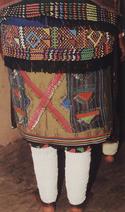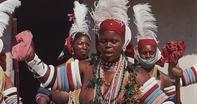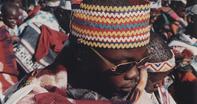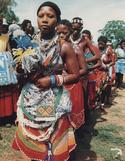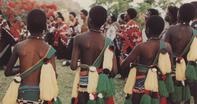
Other Accessories
Dress and Adornment of Rural South Africa
Like plastic beads, accessories such as safety pins are comparatively inexpensive but aesthetically effective. Items like these are now also used in the production of wall hangings for urban consumers.
Combining traditional clothing and beadwork with accessories intended for other purposes has become increasingly common. Among the BaNtwane, Christmas decorations and plastic trinkets add dramatic accents to the wearer's dress, including sparkling colour.
The innovative use of richly patterned or coloured cloths also affords important aesthetic accents. While these cloths and other decorations reinforce the shapes of items like headdresses, they also help to soften their contours.
At their coming-out ceremonies, some male South Sotho initiates wear sunglasses as a sign of deference and worldliness. In some communities, women wear sunglasses for similar reasons.
Female initiates often carry ribbons with artificial flowers, probably in emulation of the accessories carried by modern-day brides.
Frontal view The Swazi practice of fashioning decorations from wool can be compared to the use of plastic beads, in that items made from these materials do not require long hours of labour. In the 19th century during the reign of the third Zulu king, Mpande, members of the royal family and the king's warriors wore accessories made from wool obtained from the traders at Port Natal, later Durban.
By Professor Sandra Klopper
